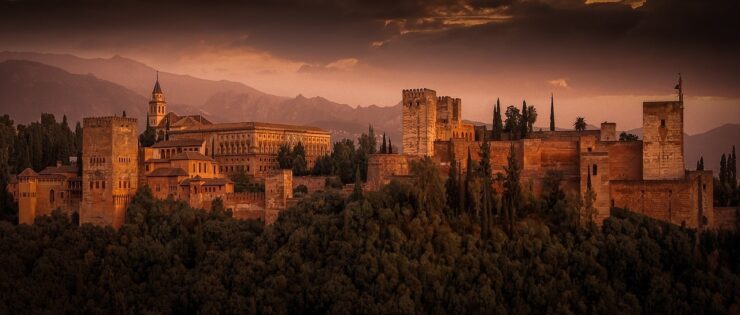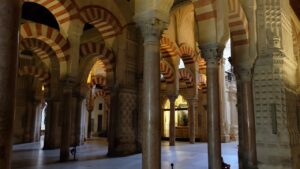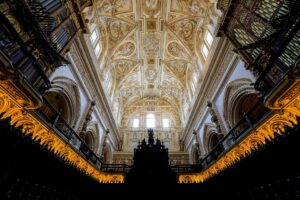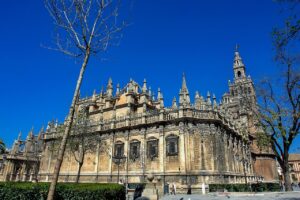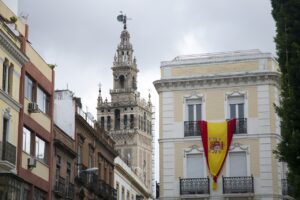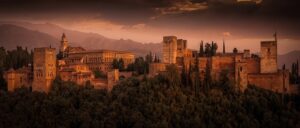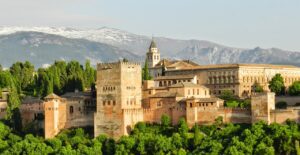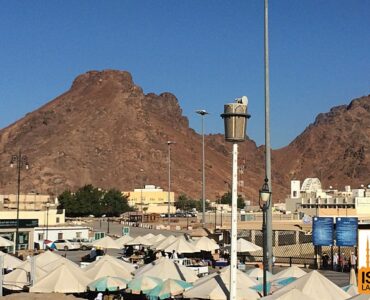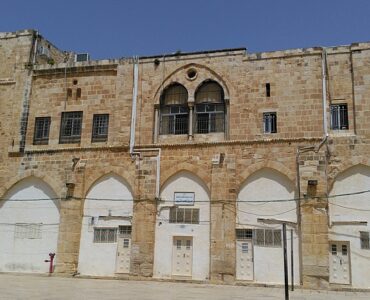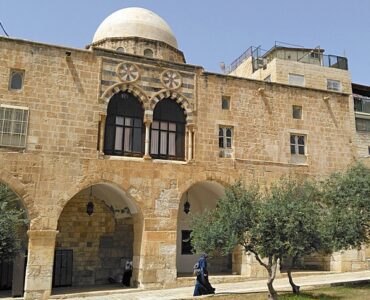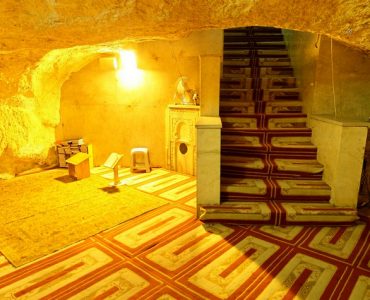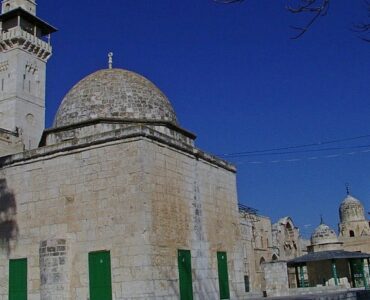The Muslim Moors exerted their influence over Spain throughout the medieval era, leaving an enduring imprint on Spanish architecture that remains visible to this day.
Despite the Christian reconquest of the Iberian Peninsula (the Reconquista), during which numerous Islamic structures, particularly places of worship, were either demolished or repurposed as churches, a handful managed to survive, standing tall as reminders of the Muslim rule.
Continue reading to learn about the ten majestic mosques in Spain.
Which Spanish City Has a Famous Mosque?
The Spanish city that has a famous mosque is Cordoba. Also called Mezquita-Catedral de Cordoba, the Great Mosque of Cordoba is one of the greatest monuments in Spain and a prime example of Islamic architecture.
The culture and food of Cordoba are a mixture of all three religions: Christianity, Islam, and Roman paganism.
What Is the Biggest Mosque in Spain?
Mezquita-Catedral de Cordoba or the Great Mosque of Cordoba is the biggest Masjid in Spain.
The Great Mosque of Córdoba
Mezquita-Catedral de Cordoba is a magnificent historical monument located in the city of Cordoba, Spain.
The Great Mosque of Cordoba is renowned for its rich history, stunning architecture, and the interplay of various cultural influences.
Here is an overview covering the history, facts, design and architecture, location, capacity, and the current status of Mezquita-Catedral de Cordoba:
History
The religious heritage of the Great Mosque of Cordoba dates back to the 8th century. It was initially constructed as a small mosque during the rule of the Umayyad dynasty.
However, under the reign of Abd al-Rahman I, the Mosque was expanded and developed into one of the most significant Islamic architectural wonders in the world.
The construction took several phases and rulers over centuries, resulting in a structure that reflects a blend of Islamic, Moorish, and Christian elements due to the region’s complex history.
Facts
- The grave of Abd al-Rahman can be found under the site of the Great Mosque of Cordoba.
- Abd al-Rahman I constructed the Masjid in honour of his beloved wife and originally named it “Aljama Mosque.”
- The Mosque comprises a 180-metre by 130-metre complex and an enclosed courtyard.
- 1984 Mezquita-Catedral de Cordoba was enlisted as an UNESCO World Heritage Site.
- The Great Mosque of Cordoba was built on the site of the Visigoth church.
- The prayer hall of the Mezquita consists of 856 columns.
Design and Architecture
The design of the Great Mosque of Cordoba exhibits a harmonious blend of Islamic and Western architectural styles.
It features a large hypostyle prayer hall with a forest of columns and horseshoe arches supporting the roof.
The arches are alternately coloured red and white, creating a mesmerising visual effect. The mihrab (prayer niche) is exquisitely decorated with intricate mosaics and inscriptions.
The structure also includes a beautiful courtyard with orange trees and a reflecting pool, adding to its serene vibe.
Location/Address
Calle del Cardenal Herrero, 1, 14003 Córdoba, Spain. Click here to view the location of the Great Mosque of Córdoba.
Capacity
While the exact number isn’t known, Mezquita-Catedral de Cordoba can accommodate thousands of worshipers during prayer times.
Its large prayer hall, with its multitude of columns and arches, provides ample space for visitors, tourists, and worshipers.
Is It Still a Mosque, or Has It Been Converted into a Church?
After the Christian Reconquista of Cordoba in the 13th century, the Mosque was converted into a Christian cathedral.
As a result, the Mosque’s Islamic features were preserved, while Christian elements such as chapels and the choir were integrated into the structure.
The cathedral was constructed at the heart of the Mosque’s prayer hall, creating an intriguing fusion of architectural styles and spiritual traditions.
Opening Hours
Monday – Saturday: 10 am to 6 pm.
Religious Festivals and Sundays: 9 am to 10:30 am and 2 pm to 6 pm.
Ticket Prices
Guided Tours cost 40€ per person. However, it is free for children under the age of 8.
The cost of private tours (without a guide) is 10€ per person, 5 € for children (10-14 years old), and free for children under the age of 10
Images
Phone Number
info@mezquitadecordoba.org or informacion@mezquita-catedraldecordoba.es
Opening Date
The construction of the Great Mosque of Cordoba began in the year 785 CE during the rule of Abd al-Rahman I and was opened to the public in 988 CE.
Its expansions and modifications continued through various dynasties and rulers until it reached its present form. The cathedral within the Mosque was consecrated in the 13th century.
Masjid Tarek Ibn Ziyad – Biggest Mosque in Barcelona
Named after the fierce warrior Tariq Ibn Ziyad, Masjid Tarek Ibn Ziyad was made after the Muslim conquest of Barcelona.
The Mosque’s architectural blend of contemporary design and traditional Islamic elements reflects the harmonious coexistence of modernity and tradition.
With its serene ambience and the echoes of prayers that resonate within its walls, Masjid Tarek Ibn Ziyad not only fulfils the spiritual needs of its attendees but also fosters understanding and dialogue among different faiths in the heart of Barcelona.
History
Masjid Tarek Ibn Ziyad, named after the valiant Berber-Muslim general who led the conquest of Hispania in the 8th century, holds an array of historical echoes within its walls.
Founded in the early 9th century, this Mosque is a silent witness to the passage of time and the ebb and flow of empires.
From its inception during the Umayyad Caliphate to surviving the tumultuous eras of Moorish Spain and beyond, the Mosque has imbibed the essence of each era.
Facts
- Masjid Tarek Ibn Ziyad was established in the 9th
- Masjid Tarek Ibn Ziyad is one of Barcelona’s largest and most historic
- The Mosque was named after the Muslim commander Tariq ibn Ziyad.
Design and Architecture
Masjid Tarek Ibn Ziyad’s architecture is a testament to its builders’ skilled craftsmanship.
The Umayyad plus Moorish architectural design of the Mosque includes horseshoe arches, geometric patterns, and ornate calligraphy that adorn the walls.
Location/Address
C/ de Sant Rafael, 10, 08001 Barcelona, Spain.
Capacity
Being the largest Mosque in Barcelona, Masjid Tarek Ibn Ziyad can accommodate thousands of worshippers in its prayer hall.
Is It Still a Mosque, or Has It Been Converted into a Church?
Fortunately, Masjid Tarek Ibn Ziyad is one of the few mosques that haven’t been converted into a church.
Opening Hours
The Mosque is open at all hours.
Ticket Prices
Masjid Tarek Ibn Ziyad is open to the public for free.
Phone Number
There’s no email address associated with Masjid Tarek Ibn Ziyad.
Opening Date
Masjid Tarek Ibn Ziyad was open to worshippers in the 9th century.
Madrid Central Mosque
The Madrid Central Mosque, also known as the Abu-Bakr Mosque, holds a significant place in the history of Islamic architecture and culture in Spain.
It was established as a spiritual and cultural centre for the Muslim community in Madrid.
The Mosque’s history is intertwined with Spain’s rich Islamic past, harkening back to the period of Al-Andalus when Muslim rule left an indelible mark on the region.
In addition to being a place of worship, the Madrid Central Mosque is also used for social, cultural, educational, and charitable purposes.
Due to its proximity to the Strait (Estrecho) Metro Station, the Masjid was also named “Strait Mosque.”
History
After being allotted as Waqf land, a considerable span of time was required to amass adequate individual donations, eventually paving the way for the Mosque’s construction.
Inaugurated in 1988, this establishment marked a historic moment by becoming the first Mosque in the capital since the conclusion of Islamic rule in 1085.
The architectural vision was brought to life by Juan Mora, and it presently serves as the central hub for both the Union of Islamic Communities of Spain and the Islamic Community of Madrid.
The Abu-Bakr Mosque operates under a collaborative agreement with the Community of Madrid and maintains a significant connection with the State through the Islamic Commission of Spain.
Facts
- Abu-Bakr Mosque is the first Masjid built since 1089 AD.
- Juan Mora designed the Mosque.
- Construction of Madrid Central Mosque was completed in 1988.
- It is the headquarters of the Islamic Community of Madrid and the Union of Islamic Communities of Spain.
- Madrid Central Mosque has four floors, including a school, offices, a nursery, an auditorium, a shop, and a library.
Design and Architecture
Masjid-e-Abu Bakr’s design and architecture are greatly inspired by Islamic art and Arab architectural principles.
The four-floor Mosque includes a shop, an auditorium, a library, a school, a nursery, offices, a café, and a mosque. The central dome, minaret, and prayer hall are key features of the Madrid Central Mosque.
Location/Address
Madrid Central Mosque is situated in the Cuatro Caminos neighbourhood of the Tetuán district.
The exact address is Calle Anastasio Herrero, 5, 28020 Madrid, Spain. Click here to view the location of one of the most popular mosques in Spain.
Capacity
Comprising four floors, the Madrid Central Mosque has a generous capacity to accommodate many worshippers.
Is It Still a Mosque, or Has It Been Converted into a Church?
Madrid Central Mosque isn’t only a masjid but the headquarters of the Islamic Community of Madrid and the Union of Islamic Communities of Spain.
The Mosque hosts all of the congregational prayers and is also used for educational, charitable, and cultural purposes.
Opening Hours
Monday – Sunday: 9 am to 10 pm.
Ticket Prices
There is no information available on the ticket price of the Madrid Central Mosque. It is possible that the Mosque does not charge a visitor’s fee.
Images
Phone Number
Opening Date
The Madrid Central Mosque opened its doors to the public in 1988, marking a significant milestone in preserving and continuing Islamic heritage in Spain.
3 Spanish Mosques Converted into Churches
In this section, we will discuss the three Spanish mosques that were converted into Churches after the Christian Reconquista.
Mosque of Cristo De La Luz
Also called Mezquita de Toledo, Cristo de la Luz Mosque is a historic religious site in Toledo, Spain. Holding significant architectural and historical importance, the Cristo de la Luz Mosque represents the religious and cultural transition that occurred in Spain over centuries.
It was also one of the ten blessed ancient mosques that stood during the Moorish era. Like most Islamic monuments, the Cristo de la Luz Mosque was later converted into a church in 1085 CE. Cristo de la Luz Mosque is one of the best-preserved mosques in Spain.
History
Originally built during 999 CE under the rule of the Umayyad Caliphate, the Mosque served as a place of worship for the Muslim community in Toledo. According to scriptures, Ahmad ibn Hadidi paid for the construction of the Mosque out of his own pocket.
It showcases a distinctive blend of Islamic architectural elements, such as horseshoe arches and intricate stucco decorations, which are characteristic of the Moorish style.
Facts
- The name “Cristo de la Luz” (Christ of the Light) was given to the Mosque after the Christian conquest of Toledo, reflecting its transformation into a Christian religious site.
- Cristo de la Luz Mosque measures 8×8 metres.
- Cristo de la Luz Mosque was constructed in 999 CE and was converted into a Church in 1085 CE.
- Cristo de la Luz Mosque was also called Bab al-Mardum Mosque.
Design and Architecture
Showcasing a blend of the Visigothic and Moorish cultures, Cristo de la Luz Mosque consists of geometric patterned small stone and brick walls, white-coloured horseshoe arches, and Islamic inscriptions on the wall.
The 8×8 square-shaped building has 4 columns that further divide into 9 parts. However, in 1186 CE, Cristo de la Luz Mosque was transformed into a chapel, resulting in the destruction of the mihrab and Qibla wall.
Cristo de la Luz Mosque features a beautiful garden and glass floors to preserve the authentic architectural design of the Moorish period.
Location/Address
Cristo de la Luz Mosque is located at Calle Cristo de la Luz, s/n, 45002 Toledo, Spain. Click here to view the exact location of Cristo de la Luz Mosque on Google Maps.
Capacity
Measuring 8×8 metres only, Cristo de la Luz Mosque isn’t particularly large and was likely designed to accommodate a moderate number of worshipers during its use as a mosque.
Is It Still a Mosque, or Has It Been Converted into a Church?
After Toledo was recaptured by Christian forces in the late 11th century, the Mosque transformed. It was consecrated as a Christian church, and an altar was added.
The Mosque’s original architectural elements were preserved, but new Christian iconography and religious features were integrated.
Upon stepping inside, Muslims can feel the religious spirit of the Mosque, especially after reading the Kufic script inscriptions on the walls.
Opening Hours
The Cristo de la Luz Mosque welcomes visitors from Monday to Sunday, with opening hours varying based on the season. Plan your travel accordingly.
March 1st to October 15th: 10am to 6:45pm
October 16th to February 28th: 10:00 am to 05:45 pm
Ticket Prices
- General Ticket:80 €
- Accredited Groups:40 €
- Minors Under 11: Free
Phone Number
+34 925 25 41 91
mezquitaermitacristodelaluz@gmail.com
Opening Date
The construction of the Cristo de la Luz Mosque was completed in 390 AH in the month of Muharram.
Giralda (The Great Mosque of Ishbiliya)
Standing as an emblem of historical significance and architectural marvel, the Giralda Tower is one of the most popular tourist sites in Spain.
Originally belonging to the Great Mosque of Ishbiliya, the Giralda tower showcases the power of Islam and the peace and harmony that prospered during the Umayyad Era.
History
The Great Mosque of Ishbiliya also recognised as the “Muvahiddin Mosque,” was constructed in 1171 during the reign of Abu Ya’qub Yusuf. It was built on the present-day location of the Seville Cathedral.
Designed with a rectangular layout, the Mosque featured a porticoed courtyard on its northern facade, with the notable Puerta del Perdón, the largest entrance among the three, still extant today.
Tragically, the Mosque suffered extensive damage from the earthquake in 1356, decimating much of its structure, except for the minaret and the courtyard named “Patio de los Naranjos” in Spanish.
Following the invasion of Ishbiliye by King Fernando III of Castille in 1248, the Grand Mosque of Ishbiliye underwent a transformation into a cathedral. Serving as a cathedral for almost two centuries, the Mosque’s primary edifice was entirely dismantled in 1434 to make way for the construction of the Seville Cathedral.
The minaret that once belonged to the Ishiliye Mosque underwent a conversion into a bell tower, subsequently integrated into the cathedral’s architecture completed in 1507. Notably, in 1568, the addition of a rotating statue atop the minaret led to its popular designation as the Giralda.
Facts
- Rising to a height of 343 feet (104.1 metres), the Giralda was one of the tallest structures of its time and still dominates the skyline of Seville.
- The Giralda was actually the minaret of the Great Mosque of Ishbiliya.
- It was originally built in the year 1171.
- The Giralda Tower is 341.5 feet (104.1 metres) in height.
- The Giralda Tower was added by UNESCO to the World Heritage List in 1987.
Design and Architecture
As stated earlier, Giralda is not actually a mosque but a 341.5 feet (104.1 metres) sky-high minaret of the Great Mosque of Ishbiliya. The lower section of the minaret is unmistakably Almohad, with its intricate brickwork patterns and horseshoe arches.
As the tower rises, the upper portion reflects Renaissance influences, featuring classical columns and a statue known as “El Giraldillo,” which represents triumph over adversity.
This amalgamation of styles symbolises the city’s diverse cultural past.
Location/Address
Avenida de la Constitucion s/n, 41004 Seville, Spain. Click here to view the location.
Capacity
The capacity of the Giralda tower is unknown.
Is It Still a Mosque, or Has It Been Converted into a Church?
The Giralda Tower is no longer a mosque. Following the Reconquista, it became part of the Seville Cathedral complex. The tower’s role transformed from a minaret to a bell tower and remains an integral part of the cathedral.
Opening Hours
- Monday: 11 am – 3:30 pm
- Tuesday – Saturday: 11 am – 5 pm
- Sunday: 2:30 pm – 6 pm
Ticket Prices
- General Ticket: €9
- Reduced Admission: €9
- Audio Guide: €3
Images
Phone Number
Opening Date
The foundation of the Giralda Tower was laid in 1171. However, it was renovated into a ring tower in 1248 and then was revamped again in the late 16th and mid-17th century.
The Mosque of Almonaster la Real
Built in the 10th century, the Mosque of Almonaster la Real is a uniquely shaped stone and built building.
Featuring the authentic Visigoth architectural design, the Mosque of Almonaster la Real is located on a hill inside a castle that overlooks the Almonaster la Real village, hence its name.
The Mosque was renovated into a church after Christians regained control of Spain.
History
The history of the Mosque of Almonaster la Real traces back to the 10th century when the region was under the rule of the Umayyad Caliphate of Córdoba.
At this time, the Mosque was constructed as a worship centre for the Muslim community residing in the city.
This period marked the zenith of Islamic rule in the Iberian Peninsula, bringing with it a flourishing of art, science, and architecture.
However, with the passage of centuries, the region witnessed the ebb and flow of power dynamics. As Christian forces reconquered Spain, the Mosque transformed.
In the 13th century, during the reign of King Ferdinand III, the Mosque was converted into a Christian church. This transition encapsulates the historical and religious shifts that marked the region’s complex past.
Facts
- The Mosque of Almonaster la Real was built in the 10th century during the caliphate of Abd al-Rahman III.
- Sixteen tombs were discovered in the Mosque’s oration room.
- In 1931, the Mosque of Almonaster la Real was declared a National Monument.
Design and Architecture
The Mosque of Almonaster la Real has a trapezoidal architectural structure and is divided into three distinct sections: the prayer hall, a minaret tower, and a courtyard of ablutions.
Within the prayer hall, a layout of 5 minor naves is discernible. Notably, the central nave boasts a distinctive covering comprising a hemispherical dome and intricate brick arches.
While the rock facade courtyard is still intact, the brick and stone minaret tower has undergone various expansions and extensions over time.
Location/Address
Castillo, 10, 21350 Almonaster la Real, Huelva, Spain. Click here for the location.
Capacity
The capacity of the Mosque of Almonaster la Real remains unknown.
Is It Still a Mosque, or Has It Been Converted into a Church?
Today, the Mosque of Almonaster la Real stands as a church, inviting individuals to tour the architectural marvel.
Opening Hours
Monday to Sunday: 9 am to 8:30 pm.
Ticket Prices
There is no entrance fee.
Phone Number
Opening Date
The Mosque of Almonaster la Real was open to the public in the 10th century. However, the exact date is unknown.
How Many Mosques Were Destroyed in Spain?
During the Muslim rule in al-Andalus, there existed possibly thousands of mosques in Spain.
However, a majority of the religious buildings and Masjids were converted either into churches or demolished after the Christians regained control of Spain in 1492 (Reconquista).
According to the 2018 report by the Observatory of Religious Pluralism in Spain (El Observatorio del Pluralismo Religioso en España), approximately 1588 Muslim worship places were constructed in Spain.
However, as per another source, there were over 137 mosques in Grenada and about 3,000 mosques in Cordoba alone in the 10th century. These mosques served over 1.5 million Spanish Muslims during the Umayyad Era.
Alhambra Mosque
The Alhambra’s creation was not attributed to a singular ruler, but instead, it emerged as the collaborative effort of successive leaders within the Nasrid dynasty.
History
The Alhambra is a historic building — a palace and fortress complex located in Granada City, Spain. Its history dates back to the 9th century when the original structure was constructed as a small fortress.
However, the most significant developments and expansions occurred during the Nasrid Dynasty in the 13th and 14th centuries.
The Nasrid rulers transformed the fortress into a stunning palace complex that combined Islamic architecture and art with elements of Andalusian culture.
Facts
- The name “Alhambra” is derived from the Arabic words “al-Qal’a al-Hamra,” which means “the Red Fortress” due to the colour of its walls.
- It is a UNESCO World Heritage Site, recognised for its exceptional architecture and cultural significance in 1984.
- The Alhambra is renowned for its intricate tilework, geometric patterns, and lush gardens.
Design and Architecture
The architecture and design of the Alhambra Palace stand as a captivating fusion of Islamic artistry, Moorish craftsmanship, and Andalusian aesthetics.
The Nasrid Palaces, at the heart of the complex, are a testament to the mastery of architectural geometry and spatial arrangement.
The Palacio de los Leones (Palace of the Lions) boasts a central courtyard adorned with a breathtaking fountain supported by intricately sculpted marble lions – an emblem of the harmony between human ingenuity and the natural world.
Wooden ceilings adorned with intricate designs add to the allure, while the Generalife gardens extend an invitation to serenity with their terraced layout, bubbling water channels, and meticulously cultivated flora.
Location/Address
The Alhambra is located on Calle Real de la Alhambra, s/n, 18009 Granada, Spain.
If you want to travel to the Alhambra, click here to see the location on Google Maps.
Capacity
The capacity of the Alhambra varies based on the specific areas visitors are allowed to access. It receives a large number of visitors annually.
Is It Still a Mosque, or Has It Been Converted into a Church?
The Alhambra was originally built by the Nasrid Dynasty as a Muslim palace and fortress.
However, after the Reconquista (the Christian reconquest of Spain), the building was not converted into a church.
Instead, some parts were repurposed for Christian use, but the majority of the architectural and artistic features of the Nasrid period were preserved.
Today, Santa Maira de le Alhambra, a catholic church, stands on the site of Alhambra Mosque.
Opening Hours
1st April to 14th October
- Monday – Sunday: 8:30 am to 8 pm
- Ticket Office: 8 am to 8 pm
15th October to 31st March
- Monday – Sunday: 8:30 am to 6 pm
- Ticket Office: 8 am to 6 pm
Ticket Prices
- Adults: 19.09€
- Children between 12 and 15 years old: 12.73 €
- Children under 12: Free admission
Images
Phone Number
+34 677 417 790 or +34 958 027 971
informacion.alhambra.pag@juntadeandalucia.es.
Opening Date
The exact opening date of the Alhambra Mosque is unknown.
Great Mosque of Almeria
The Great Mosque of Almeria, also known as the Mezquita de Almería, is a historic architectural gem in Almeria, Spain.
This famous Mosque holds a significant place in the region’s history, reflecting the cultural and architectural influences of various civilisations that have shaped its evolution.
Mezquita de Almería was transformed into a San Juan church after Christians regained power in Spain.
History
The Great Mosque of Almeria was originally constructed during the 10th century when Almería was under the rule of the Umayyad Caliphate of Córdoba.
The Mosque was built during the reign of Caliph Abd ar-Rahman III.
It served as a place of worship and a centre of learning for the Muslim community in the region.
After being converted into a church, the Great Mosque of Almeria was destroyed in the 1522 earthquake, and all that remained was the mihrab alcove and the qibla wall.
Facts
- The Great Mosque of Almeria was established in the 10th
- The Great Mosque of Almeria was built during the reign of Abd ar-Rahman III.
- After being converted into a church, the name of the Mosque was changed to Church of San Juan.
Design and Architecture
The Mosque’s architecture showcases a rectangular layout with a prayer hall featuring a central nave flanked by aisles.
The Great Mosque of Almeria also featured a quadrangular mihrab, a lemon-plated patio, and a central fountain.
According to Islamic history, Mezquita de Almería was a part of Alcazaba of Almeria, a larger fortified complex that contained a palace, homes, and public baths.
Location/Address
The Great Mosque of Almeria is located on Plaza de la Constitución, s/n, 04003 Almería, Spain Almería. Click here to view the directions.
Capacity
The Great Mosque of Almeria can accommodate over 9000 worshippers.
Is It Still a Mosque, or Has It Been Converted into a Church?
The Great Mosque of Almeria has undergone various transformations over the centuries.
Following the Reconquista, the Christian conquest of the Iberian Peninsula, the Mosque was converted into the Church of San Juan.
The building was consecrated as the Cathedral of the Incarnation (Catedral de la Encarnación) and underwent subsequent modifications to align with Christian architectural styles.
Opening Hours
- Summer (April to October): 9 pm to 2 pm.
- Winter (November to March): 9 pm to 6 pm.
Ticket Prices
- Standard Ticket: 3-5 €
- Group Ticket (10 people): 2-5 €
- Reduced Ticket: 1-5 €
Images
Phone Number
Unfortunately, there’s no valid email address to contact the Great Mosque of Almeria.
Opening Date
The original Great Mosque of Almería was likely constructed in the 10th century. Following its conversion into the Cathedral of the Incarnation, it underwent modifications and renovations over the centuries.
The conversion into a cathedral marked a significant transition in its history after the Reconquista.
Alcazar of Jerez de la Frontera Mosque
An illustrious and commanding monument deeply ingrained in Spain’s historical narrative, the Moorish rulers of Andalusia originally erected the Alcazar Jerez de la Frontera during the 11th century.
Distinguished by its grand towers and formidable 4000-metre walls, the balcony of the Alcazar Jerez de la Frontera Mosque offers a panoramic view of the town below.
History
The Alcazar of Jerez de la Frontera Mosque traces its origins back to the 11th century during the rule of the Almoravid dynasty.
This famous Mosque was constructed during a time when the Iberian Peninsula was under Islamic rule, a period known for its remarkable architectural achievements.
The Mosque served as a place of worship and spiritual reflection for the Muslim community in Jerez de la Frontera.
Following the 13th-century Christian conquest, the Mosque went through various renovations to align with the Christian architectural styles.
Facts
- Alcazar of Jerez de la Frontera Mosque is one of the first Islamic monuments built in the 11th
- After the Christian Reconquista, the Mosque served as a residential space for the Cadiz governors.
- In 1931, Alcazar of Jerez de la Frontera Mosque was marked by UNESCO as a world heritage site.
- Alcazar of Jerez de la Frontera Mosque is the region’s only Masjid that is preserved in its original state out of 18 others.
Design and Architecture
The 4000-metre-wide Mezquita, or Mosque, stands as a remarkable survivor among the 18 mosques that once graced the Moorish Jerez.
Originally a small private oratory, it boasts a minaret, a courtyard with a central fountain for ablutions, and a prayer hall crowned by a mihrab, indicating its orientation towards Mecca.
While the Mosque underwent a transformation into a Christian chapel dedicated to Saint Mary, its architectural elements, including the octagonal dome and the intimate atmosphere, still exude a sense of spiritual sanctity.
The Alcázar’s structures reflect its diverse history. Islamic remnants, such as the Puerta del Campo gateway and the Torre Octógonal watchtower, harken back to the rule of the Almohad Dynasty.
Location/Address
Alcazar of Jerez de la Frontera Mosque is located within the Alcazar of Jerez de la Frontera complex. Address: Alameda Vieja, s/n, 11408 Jerez de la Frontera, Cádiz, Spain.
Capacity
Having a 4000-metre ground space, the Alcazar of Jerez de la Frontera Mosque can easily accommodate hundreds of worshippers.
Is It Still a Mosque or Has It Been Converted into a Church?
Today, hundreds of years later, the former Mosque remains a significant cultural landmark that reflects the city’s complex history. The architecture is a visual chronicle of the successive civilisations that have shaped the region.
Visitors to the site can explore the remnants of the Mosque’s Islamic origins while also experiencing the subsequent Christian modifications that have left an indelible mark on its design.
Opening Hours
October 1st to June 30th:
- Monday – Friday: 09:30 am – 02:30 pm
July 1st to September 30th:
- Monday – Friday: 09:30 am – 05:30 pm
- Saturday – Sunday: 09:30 am – 02:30 pm
Ticket Prices
- General Ticket: 5 €
- Group Ticket: 4 € per person
Images
Phone Number
The only way to contact the Alcazar of Jerez de la Frontera Mosque management is through the aforementioned phone number.
Opening Date
The Alcazar of Jerez de la Frontera Mosque was inaugurated in the 11th century. However, the exact date remains unknown.
List of Former Mosques in Spain
Below, you will find a list of former masjids in Al-Andalus that have been identified with original buildings or still have ruins of the existing Mosque on the premises:
- Great Mosque of Cordoba
- Mezquita Bab-al-Mardum
- Great Mosque of Seville
- Mezquita de Almonaster la Real
- Mosque of las Tornerías
- Mezquita del Alcázar de Jerez la Frontera
- Aljama Masjid of Madinat al-Zahra
- Mezquita de Tortoles
- Al-Dabbagin Masjid
- Small Royal Mosque inside Aljaferia Palace
- Iglesia de El Salvador, Toledo
- Masjid al-Ta ibin, Mezquita de los Conversos
- San Sebastian Minaret (Alminar De San Sebastian)
- Iglesia de Santigo del Arrabal, Toledo
- Alminar de San Juan
- Church of Nuestra Señora de la Encarnacion
Listed below are the mosques in Spain that were completely destroyed, and the ruins remained undiscovered to date:
- Great Mosque of Zaragoza (Aljama de Saraqusta, Mezquita Mayor de Zaragoz)
- Mosque of Ibn Abbas
- Aljama Mosque of Mayrit
- Nasrid Great Mosque of Granada
- Basílica de Santa María de la Asunción
- Baza Cathedral
- Guadix Cathedral
- Valencia Cathedral
- Santa Catalina, Valencia
- Old Cathedral of Lleida
- Iglesia de San Román, Toledo
- Mimbar de Alfacar
- Church of Santa Maria de Tarifa
- Iglesia de San Mateo
Summary – Mosques in Spain
Conquered by Muslims in the year 711 CE, Spain underwent a transformative journey religiously, economically, and socially.
Despite the challenges posed by the Reconquista, several mosques and churches remain a reminder of Islam and Arab architecture.
If you are planning a halal travel or vacation vacation, visit any of the aforementioned mosques in Spain.
Use the opportunity to learn and explore Islamic history and reflect on how the religion has shaped the nation’s identity

